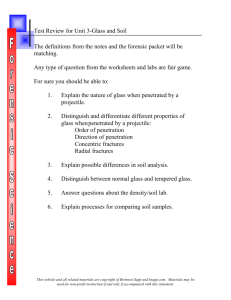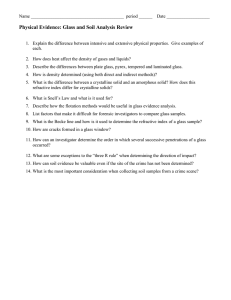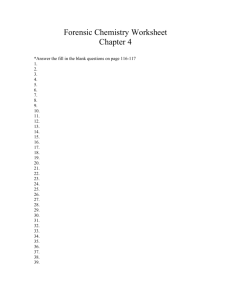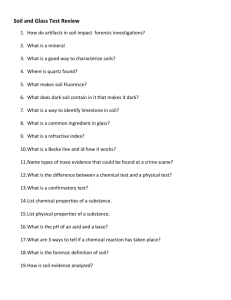Glass and soil PPT
advertisement
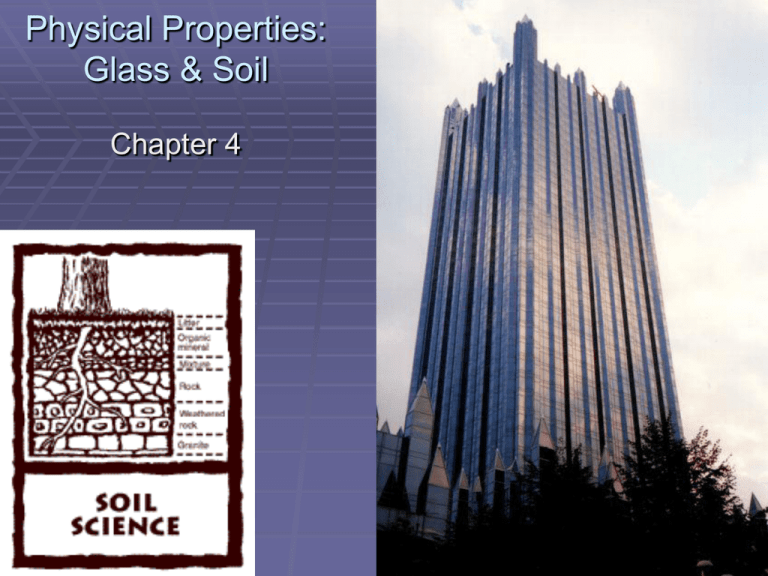
Physical Properties: Glass & Soil Chapter 4 Physical & Chemical Properties Physical properties describe a substance without reference to any other substance. Ex. Weight, volume, color, boiling point, & melting point Chemical property describes the behavior of a substance when it reacts or combines with another substance. Ex. Wood burning or to test for heroin chemical reagent Marquis reagent turns purple when positive Comparing Glass Fragments •Glass that can not be physically Glass is hard, brittle, pieced together glass is compared amorphous that is made sand, silicon oxides & metal oxides with refractive index and Borosilicates use boron oxides density to increase heat resistance ex) pyrex, headlights Tempered Glass- increased strength by adding stress through rapid heating & cooling; it doesn’t shatter, it dices into small squares ex) side and rear windows of cars Laminated glass- 2 sheet of glass sandwiching plastic Methods for Distinguishing Glass Density Densities of Some Common Materials Methods for Distinguishing Glass Refractive Index When light travels from one medium to another its speed changes relative to the density of the medium. This can be observed as the light bends when traveling from one medium to another. Refractive Index Refractive Index Tutorial Methods for Determining Refractive Index The FBI has a database off over 2000 refractive indexes of different types of glass which shows that glass is very distinctive and helps assign an appropriate statistical probability that the two pieces of glass share a common source. Methods for Determining Refractive Index Becke Line Methods for Determining Refractive Index Refractive Index changes with temperature Glass Fracture Patterns Impact Fractures Impact causes a pane of glass to bulge –Side opposite the impact will stretch more & rupture first • Radial cracks are rapidly propagated in short segments from the point of impact Glass Fractures Fracture pattern of glass is radial (extends outward like spoke o a wheel) & concentric lines (rough circle around point of impact) Crater-shaped hole in glass made by penetration indicates the exit side of glass Stress marks on the edge of a radial crack near the point of impact are parallel to the side on which the force was applied Glass Fracture Patterns Glass Fracture Patterns Glass Fracture Patterns 3R rule – Radial cracks form a Right angle on the Reverse side of the force Stress Marks Stress marks on the edge of a radial crack near the point of impact are parallel to the side on which the force was applied Three ‘R’ Rule Radial cracks are at Right angles to the Rear (side opposite the impact) Exceptions –tempered glass “dices” without forming ridges –very small windows held tightly in frame can’t bend or bulge appreciably – windows broken by heat or explosion no “point of impact” Scenario: A storefront window is broken and a robbery committed. A suspect is later found running from the scene. Examination of his shoes reveals glass particles embedded in a heel. Describe the proper collection and preservation of glass evidence for laboratory examination. The entire shoe is to be submitted for lab examination. The evidence collector is to avoid removing glass evidence from the shoe unless there is a distinct possibility that the glass will be lost in transit. Shoes are to be packaged in a box or paper bag and sent to the lab. A control glass from the broken window is to be submitted for laboratory examination. Normally a square-inch piece of glass will suffice. A pillbox, druggist fold or vial are convenient containers for small glass fragments. All packages are to be properly labeled for id. Minimal info should contain evidence collector’s name, date and sampling location. All evidence are to be described in field notes. Collection of Glass Evidence Standard reference glass should be taken from the crime scene (1 in2) Package in solid containers to prevent breakage Preserve garment (shoe, pants, shirt) with glass on it Comparing Soils Mineral: 2,200 naturally occurring crystal Physical properties: color, geometric shape, density, refractive index (birefringence) The difference between the two indices of refraction for calcite: 1.486 & 1.658 birefringence for calcite is 0.172 Density-gradient tube: a glass tube filled from bottom to top with liquids of successively lighter densities; used to determine the density destruction of soil Soil Characteristics Mixture of: Weathered rock and minerals (quartz, mica, feldspar) Humus (decomposed organic material) Other vegetable matter (leaves, pine needles, pollen, etc) Manufactured materials (asphalt, paint, glass) Soil Analysis 1st – Gross Analysis Color and Texture Analysis 1,100 distinguishable colors of soil Darker when wet Soil Analysis 2nd – Microscopic Analysis Rock and Mineral Analysis Minerals have physical properties like color, crystal shape, density, and refractive index 2,200 minerals (40 common) Soil Analysis Microscopic Analysis con’t Humus Pollen Collection of Soil Evidence Collect samples at various intervals in a 100 yard radius of crime scene Top surface of soil is usually enough Preserve garment (shoe, pants) with soil on it Note layering of soil (as on car tires) when collecting soil evidence Scenario: A suspect has been found miles from the scene of a murder. Soil is found adhering to the suspect’s shoe. Describe the proper collection and preservation of soil evidence that will permit a thorough comparison of the soil on the shoe to soil at the crime site. Do not remove soil from shoes. Each object that has soil on it is to be packaged in a leak proof container Collect representative control soils at the crime scene and at various locations within a 100 yard radius of the scene. Package in solid containers or druggist folds Collect soil at all possible alibi locations the suspect may claim. Collect approximately 1-2 tablespoons of soil, top layer only. Label all specimens collected. Evidence collector’s name or initials, the date and sampling location are to be shown. All items collected are to be described in the evidence collector’s field notes. The End
